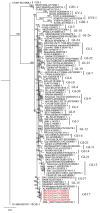Delmarva (DMV/1639) Infectious Bronchitis Virus (IBV) Variants Isolated in Eastern Canada Show Evidence of Recombination
- PMID: 31766215
- PMCID: PMC6893544
- DOI: 10.3390/v11111054
Delmarva (DMV/1639) Infectious Bronchitis Virus (IBV) Variants Isolated in Eastern Canada Show Evidence of Recombination
Abstract
Infectious bronchitis virus (IBV) infection in chickens can lead to an economically important disease, namely, infectious bronchitis (IB). New IBV variants are continuously emerging, which complicates vaccination-based IB control. In this study, five IBVs were isolated from clinical samples submitted to a diagnostic laboratory in Ontario, Canada, and subjected to detailed molecular characterization. Analysis of the spike (S)1 gene showed that these five IBVs were highly related to the Delmarva (DMV/1639) strain (~97.0% nucleotide sequence similarity) that was firstly isolated from an IB outbreak in the Delmarva peninsula, United States of America (USA), in 2011. However, the complete genomic sequence analysis showed a 93.5-93.7% similarity with the Connecticut (Conn) vaccine strain, suggesting that Conn-like viruses contributed to the evolution of the five Canadian IBV/DMV isolates. A SimPlot analysis of the complete genomic sequence showed evidence of recombination for at least three different IBV strains, including a Conn vaccine-like strain, a 4/91 vaccine-like strain, and one strain that is yet-unidentified. The unidentified strain may have contributed the genomic regions of the S, 3, and membrane (M) genes of the five Canadian IBV/DMV isolates. The study outcomes add to the existing knowledge about involvement of recombination in IBV evolution.
Keywords: Canada; Infectious bronchitis virus (IBV); chicken; complete genome sequence; phylogenetic analysis; recombination.
Conflict of interest statement
The authors declare no conflict of interest.
Figures






References
-
- Jackwood M.W., de Wit S. Infectious bronchitis. In: Swayne D.E., Glisson R.J., McDougald L.R., Nolan L.K., Suarez D.L., Nair V., editors. Diseases of Poultry. 13th ed. Volume 13. John Wiley and Sons; Ames, IA, USA: 2013. pp. 139–159.
-
- Quinteros J.A., Markham P.F., Lee S.-W., Hewson K.A., Hartley C.A., Legione A.R., Coppo M.J., Vaz P.K., Browning G.F. Analysis of the complete genomic sequences of two virus subpopulations of the Australian infectious bronchitis virus vaccine VicS. Avian Pathol. 2015;44:182–191. doi: 10.1080/03079457.2015.1022857. - DOI - PMC - PubMed
Publication types
MeSH terms
Substances
LinkOut - more resources
Full Text Sources
Other Literature Sources

